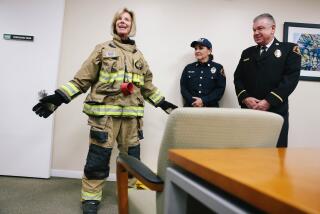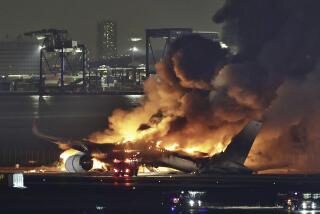FAA Seat-Cushion Rule Heats Up Burbank Supplier’s Business
- Share via
The small room suggests a torture chamber, with a flame thrower resting on a low stand aimed at a straight-backed chair of naked metal. In fact, it is for torture--of seat cushions--in a process intended to save lives in burning airplanes.
In a building behind its Burbank headquarters, the Weber Aircraft division of Kidde Inc. tests seat cushions to help U.S. airlines comply with a recent Federal Aviation Administration regulation that they add a layer of fire-retardant fabric inside their seats by 1987.
Punishing cushions with an 1,800-degree flame is just the beginning of fire-safety testing at Weber. The nation’s largest supplier of aircraft cabin equipment is preparing for a wave of fire-safety regulations that will alter the way it makes its products, and bring it additional profit.
The cushion rule is an example of how government can create a commercial market through regulation. The regulation is expected to cost the airlines $40 million to $80 million, and Weber officials expect to receive 40% of that.
Healthy Boost Expected
The trade promises to give a healthy boost to Weber, a company that is working hard to come back from rough times experienced by everyone who helps build airplanes.
In 1983, Boeing and other aircraft manufacturers dived into one of their worst slumps ever and Weber registered its poorest performance since 1976, with sales of $85 million. In 1984, the company had sales of $100 million. Projected sales for 1985 are $112 million, Weber executives say.
Last year, the division took the biggest order for airplane galleys in its 39-year history when American Airlines replaced cooking facilities in 127 planes. Such galley refitting accounts for 60% of Weber’s business with the commercial airlines.
But these days, the cushions are the cause of unprecedented demand at Weber. “We’ve never seen volume like this,” said Williams, noting that the company has delivered 2,000 new cushions since the regulation took effect in November.
18% Die in Crash Fires
The regulation was prompted by some statistics: Of the 3,000 deaths in the 90 major airplane accidents in this country since 1969, slightly more than 12% of the victims were killed by the impact of a crash. But another 18%, 419 deaths, resulted from fire that erupted after a crash, according to the National Transportation Safety Board.
Regulation has been talked about for years--far too many years without results, some consumer advocates say. A 1983 Air Canada fire that took 23 lives was the immediate inspiration for the regulatory action, or at least speeded it up, industry observers say.
Airlines have three years to comply with the seat-cushion rule from the time it took effect. In addition, the FAA on April 16 proposed a broader set of fire-safety rules that would require nearly every furnishing and structure inside commercial aircraft to be fire-resistant.
Although the seat-cushion rule requires the replacement of equipment now in use, the proposed broader rules would apply only to new equipment. Nevertheless, Weber President Earl Williams said: “It will have a significant effect in the way we do business. It will affect how we design. It will affect how we manufacture things.”
Less Hazardous Resins
For example, the guidelines proposed in April would change how Weber makes walls for galleys and bathrooms. Weber would fill the walls’ cores with metal instead of synthetic fibers. It would bond fiberglass sections with resins that produce less toxic gas in a fire than the ones now used.
Williams said the changes will mean different production methods, but no additions to the division’s work force of 2,000--1,015 in Burbank, the rest at a facility in Gainesville, Tex.
The seat regulation, meanwhile, already has spawned a mini-industry of companies making “fire-blocking” fabrics that airlines can select to bring the 400,000 seats in U.S. planes up to the new standard: That no more than 10% of a cushion, measured by weight, burn in two minutes under a 1,800-degree flame.
So Weber places sample cushions on the bare metal chair and turns on the flame thrower. The whole test, including cooling and weighing, takes seven minutes.
Up to $200 Per Seat
The airlines will pay an estimated $100 to $200 for the remodeling of each seat, including the bottom cushion and backrest. How much the broader regulations could cost the airline industry is hard to estimate at this point, said Greg Glenn, Weber’s sales administrator.
The industry that makes aircraft seats is largely unknown to the people who sit on them. “Ask the man on the street who makes the seats in an airplane and he’ll say, ‘the company that made the airplane,’ ” Williams said.
In fact, the industry is a small fraternity, dominated in the United States by three companies: The Fairchild Burns division of Fairchild Industries, in Winston-Salem, N.C.; The PTC Aerospace division of the Pullman Transportation Corp., in Bantam, Conn.; and Weber, whose Burbank operation occupies hangar-like structures left from when Lockheed owned the property.
Although the two other companies principally sell passenger seats, Weber also has a big stake in restrooms, crew seats, cockpit seats, serving carts, coffee makers and galleys, including ovens and refrigerators. The company also produces ejection seats for military aircraft.
Picky About Seats
The seat cushion may not demand Weber’s most complex technical work, but it is a product that gets a lot of attention in the airline industry.
An airline’s design for seats is among the few ways it can distinguish its cabins from those of competitors, and airlines can be very picky in putting together their cushions. Engineers at Western Airlines in Los Angeles said that, in a recent decision-making session regarding a $1.7-million order to Weber, Western executives all the way up to the airline’s chief executive officer gave seat samples a test sit.
The traditional airline seat has a slipcover over a cushion made from polyurethane foam. The new regulation requires that there be a fire-retardant cloth between the cushion and the slipcover. In one material on the market, aluminum strands are woven into fabric. Another relies on a fiberglass coating.
Weber puts the parts together, certifies that the airline’s prototype meets the new standard, then uses it as the model for mass production of cushions.
Cost Includes ‘Torture’
The cost to the airline includes the testing in the torture chamber behind Weber headquarters. The $40,000 facility, built according to an FAA design, is one of only three in the country, the other two being at Fairchild Burns and PTC Aerospace.
The chamber’s walls are fireproof. A large glass window separates it and a control room where technicians in white coats twist dials, flick switches and videotape each blazing session.
“I think the fire-blocking is a very impressive method of retarding fires,” said Rudy Kapustin, who led the National Transportation Safety Board’s investigation into the Air Canada fire.
What started the fire on June 2, 1983, has not been determined, but it began in a restroom as the plane was flying between Dallas and Toronto, Kapustin said. The pilot managed a landing in Cincinnati, but 23 of the 46 people aboard died.
Precious Extra Seconds
“The fire’s intensity increased rapidly when they opened the door and oxygen got into the environment,” Kapustin said. “Up to then it was mostly all kinds of gases and hot smoke, and it is quite possible that many people were already dead or incapacitated.”
He said that, with the fire-blocked seats, “I would say its safe to say that the chances for survival would have been increased.”
Most fires after a crash result from ruptured fuel lines. They are intense fires and, at best, the expectation is that fire-blocking material in seats could give passengers an extra 45 to 60 seconds to escape.
An in-flight fire could be stopped by the seats, according to the FAA. “Say a fire starts in a flight bag or a newspaper under someone’s seat,” said Henri Branting, an engineer with the FAA’s Technical Analysis Branch. “Well, the cushion might catch fire but the fire-blocking material would prevent the fire from spreading to another cushion.”
Debated for Years
As far as Matthew Finucane is concerned, the safety steps are coming too late. Finucane is director of air safety for the Association of Flight Attendants union. Before joining the union about a year ago, he lobbied for fire-blocking for four years as director of Ralph Nader’s Aviation Consumer Action Project.
Finucane said the debate about how best to regulate the flammable materials in airplanes has been going on for years, with the FAA proposing regulations and the industry resisting them.
“The seat fire-blocking layers were really a proven concept by 1978 or 1979, which is seven years ago, but the aviation community didn’t want to add several pounds to each seat,” Finucane said. “The fact that lightweight materials are available is what has finally prompted the FAA to admit there’s a problem and change the rules.”
Thomas Tripp, a spokesman for the Air Transport Assn., a trade group representing 30 American airlines, said pressure for cushion improvements did go back to the 1970s, but that the technology then did not make them feasible. “A lot of those early seats, you would sit in the seat and it would retain the imprint of the last occupant and the seats wore out very quickly.”
The average tourist-class bottom cushion now weighs about one pound and its backrest cushion about 1 1/2 to 2 pounds. The cushions for first-class seats weigh about twice as much.
The fire-blocking fabrics will add about 2 1/2 pounds per passenger seat, according to Weber officials. Finucane said he is pleased with the seat cushion regulation, at least for the time being. People in the industry agree with him that the ultimate solution will be a cushion foam that, by itself, is light, comfortable and fire-resistant. Such a cushion has not yet been invented but a lot of people--including the engineers at Weber--are working on it.
More to Read
Inside the business of entertainment
The Wide Shot brings you news, analysis and insights on everything from streaming wars to production — and what it all means for the future.
You may occasionally receive promotional content from the Los Angeles Times.










